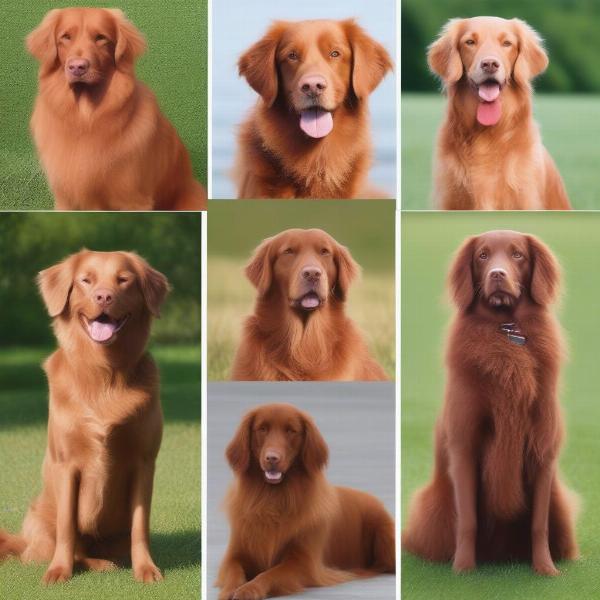Red coats in dogs are a striking and popular feature, seen across various breeds. From the deep auburn of an Irish Setter to the lighter copper of a Nova Scotia Duck Tolling Retriever, this vibrant hue adds to a dog’s individuality. But what causes this beautiful coloration? This article delves into the genetics behind the red dog coat, exploring the different shades, breed-specific variations, and how to best care for this vibrant fur. We’ll also address common questions and concerns surrounding red-coated dogs.
Red coat color in dogs is primarily determined by genetics, specifically variations in the melanocortin 1 receptor (MC1R) gene. This gene influences the production of pheomelanin, the pigment responsible for red and yellow hues. Different variations in the MC1R gene lead to the spectrum of red shades we see, from the pale cream of a Golden Retriever to the deep mahogany of an Irish Setter. Environmental factors and diet can also play a subtle role in the intensity and vibrancy of the coat, though genetics remain the primary determinant.
The Genetics of Red Dog Coats
The MC1R gene plays a crucial role in determining whether a dog will have a red coat. Specific mutations within this gene lead to the production of pheomelanin, the pigment that creates the red and yellow coloration. The intensity of the red is determined by other modifying genes and can vary widely, even within the same breed.
 Different Shades of Red in Dog Coats
Different Shades of Red in Dog Coats
Understanding the genetics behind the red coat can help breeders predict coat color in puppies. It also helps owners appreciate the complexity of canine coat coloration and the variations that can occur. For example, some dogs may have a clear, solid red coat, while others may exhibit ticking, sable patterns, or white markings. These variations are influenced by additional genes interacting with the MC1R gene.
Breed-Specific Red Coats
Several breeds are known for their stunning red coats. The Irish Setter, with its deep auburn fur, is a classic example. Other breeds known for their red coats include the Nova Scotia Duck Tolling Retriever, the Vizsla, and the Redbone Coonhound. Within each breed, there can be variations in the shade and intensity of the red, often specified in breed standards.
While the MC1R gene is fundamental to the red coat, other genetic factors contribute to breed-specific variations. These factors can influence the texture, length, and pattern of the coat, leading to the unique appearance of each breed.
Caring for a Red Dog Coat
Maintaining the vibrancy of a red dog coat requires proper care. Regular brushing helps to remove dirt and debris, preventing the coat from looking dull. A balanced diet rich in essential fatty acids can also contribute to coat health and shine. Using a shampoo specifically formulated for red coats can help enhance the color and prevent fading. Avoid excessive sun exposure, which can bleach the coat over time.
Conclusion
The red dog coat, in all its variations, is a beautiful and fascinating trait. Understanding the genetics, breed-specific variations, and proper care techniques can help owners appreciate and maintain the vibrant beauty of their red-coated companions. From the rich mahogany of an Irish Setter to the warm copper of a Nova Scotia Duck Tolling Retriever, the red dog coat is a testament to the diversity and beauty of the canine world. Remember to consult with a veterinarian or professional groomer for specific advice tailored to your dog’s breed and individual needs.
FAQ
-
What causes a dog to have a red coat? Variations in the MC1R gene primarily determine a dog’s red coat color.
-
Are red-coated dogs more prone to certain health issues? No, the red coat color itself is not linked to specific health problems.
-
Can a dog’s red coat fade over time? Yes, sun exposure and poor nutrition can cause fading.
-
What is the best way to care for a red dog coat? Regular brushing, a healthy diet, and using a color-enhancing shampoo can help maintain vibrancy.
-
Are all red dog coats the same shade? No, the shade can vary from light cream to deep mahogany due to modifying genes.
-
Are there specific breeds known for their red coats? Yes, breeds like the Irish Setter, Nova Scotia Duck Tolling Retriever, and Vizsla are known for their red coats.
-
Can I predict the coat color of puppies based on the parents’ coats? Breeders can make predictions based on genetics, but it’s not always a guarantee.
ILM Dog: Your Partner in Canine Care
ILM Dog is a leading online resource for dog owners worldwide, providing reliable and practical advice on all aspects of dog care, from breed selection and puppy care to senior dog health and training. We are passionate about empowering dog owners with the knowledge and resources they need to provide the best possible care for their furry companions. Whether you’re a seasoned dog owner or just starting your journey, ILM Dog is here to support you every step of the way. Our expertise includes insights into breeds, health, training, nutrition, grooming, and much more. We provide information on seal colored dog, customizable dog hoodie, and low carb dog food. For specific inquiries or personalized guidance, reach out to our team via email at [email protected] or phone at +44 20-3965-8624. We also have advice on dog toenail polish and clothes for teacup dogs.